Seven key methods for mould removal newcastle that work
Seven key methods for mould removal newcastle that work
Blog Article
Exploring the Different Methods and Solutions for Effective Damp Proofing
Wetness in buildings positions substantial challenges to both architectural stability and interior air quality. Various strategies and options have actually emerged to fight this pervasive concern. From traditional damp-proof membranes to innovative chemical treatments, each method uses one-of-a-kind benefits. Understanding these options is vital for efficient moisture control. However, selecting the best option depends upon certain structure problems and requirements, triggering more exploration right into the most effective wet proofing approaches readily available.
Recognizing the Reasons of Dampness
Although dampness can emerge from different resources, understanding these reasons is essential for reliable remediation. Generally, wetness stems from 3 primary resources: climbing damp, penetrating wet, and condensation. Climbing damp occurs when groundwater travels upwards through porous materials, such as brick or stone, often as a result of an absence of an efficient obstacle (mould removal newcastle). Penetrating moist is normally brought on by external variables, including roof leaks, faulty rain gutters, or damaged walls, permitting water to penetrate a residential property. Condensation, on the other hand, arises from excess dampness in the air, usually intensified by inadequate air flow and temperature level differences, resulting in water droplets developing on surfaces. Recognizing these underlying problems is necessary, as each kind of moisture calls for a tailored approach for removal. Proper evaluation aids in identifying one of the most reliable solutions, eventually guarding the structural stability of a structure and boosting indoor air quality
Conventional Damp-Proof Membrane Layers

Chemical Damp-Proofing Solutions
Chemical damp-proofing remedies supply a cutting-edge strategy to avoid moisture intrusion in buildings. These methods usually include the application of liquid chemicals that penetrate masonry and form an obstacle versus increasing moist. Commonly used chemicals include silanes, siloxanes, and various other water-repellent representatives that respond with surface materials to develop a hydrophobic layer.The application procedure normally requires drilling openings into the walls, infusing the chemical remedy, and enabling it to treat. This method is specifically useful for older frameworks where standard damp-proof membranes may be impractical. In addition, chemical damp-proofing can be much less disruptive and more cost-efficient than comprehensive remodelling projects.While effective, these remedies depend on proper application and ecological conditions for peak efficiency. Normal maintenance and surveillance are vital to guarantee the durability of the damp-proofing treatment. Generally, chemical damp-proofing represents a flexible alternative for securing buildings against moisture-related damages
Tooth Cavity Wall Surface Construction Strategies
Cavity wall building and construction techniques use numerous advantages, especially in moisture control and energy performance. By incorporating an air space in between 2 layers of masonry, these wall surfaces properly mitigate water access while boosting insulation. This mix not just secures structures from moisture however likewise adds to reduced power usage.
Advantages of Dental Caries Walls
When considering effective wet proofing techniques, the benefits of dental caries wall surfaces stand apart prominently. Tooth cavity walls are composed of 2 separate layers, developing an air space that effectively decreases wetness infiltration. This layout lessens the threat of wetness, as the external wall surface works as an obstacle versus rainfall and water access. In addition, tooth cavity walls improve thermal insulation, which adds to energy efficiency by reducing heat loss. They additionally supply audio insulation, helping to create a quieter interior setting. The air gap permits for air flow, which helps in moisture control and reduces the chance of mold and mildew development. These benefits not only boost the general comfort of a structure yet additionally add to its durability and architectural integrity.
Moisture Control Techniques
Effective dampness control techniques are critical in tooth cavity wall surface building to assure long-term security versus dampness. One main approach entails the consolidation of weep openings, which help with water drain from the cavity, protecting against accumulation. In addition, using breathable membranes can aid manage moisture degrees while allowing caught vapor to escape. Appropriate positioning of insulation is additionally vital, as it needs to not block drainage paths. Ensuring that the outer leaves of the cavity wall are built with water-resistant materials improves total sturdiness. Routine maintenance checks are vital to identify any type of blockages or damages early, safeguarding the framework's integrity. Inevitably, a combination of these techniques creates a durable defense against wetness invasion in cavity walls.
Insulation and Power Efficiency
Insulation plays an important function in boosting power effectiveness within cavity wall construction. By integrating insulating materials, these wall surfaces produce a thermal obstacle that decreases warmth loss and lowers power usage. Effective insulation not only aids maintain a stable interior temperature level however also mitigates the threat of wetness, as it protects against condensation within the wall surface tooth cavity. Various strategies, such as making use of inflexible foam boards or mineral woollen, can be utilized to accomplish optimal insulation efficiency. Additionally, appropriate installation is important to guarantee that gaps and spaces are minimized, which can or else jeopardize power efficiency. Inevitably, a well-insulated tooth cavity wall contributes significantly to total sustainability and reduces home heating and cooling prices for homeowners.
Exterior Damp Proofing Techniques
Exterior moist proofing approaches are vital for protecting frameworks from dampness infiltration. Two reliable methods consist of the application of waterproof membrane layers and the installation of French drains. These remedies help minimize water accumulation and protect the honesty of buildings.
Waterproof Membrane Application
While numerous methods exist for preventing wetness access, the application of water resistant membrane layers remains an extremely reliable outside wet proofing strategy. These membrane layers are normally made from materials such as polyethylene, rubber, or customized bitumen, giving a robust obstacle against water infiltration. The installation process includes using the membrane layer to the exterior surfaces of wall surfaces or foundations, making certain full coverage to avoid leaks. Appropriate bond and securing at joints are critical to optimizing performance. Water-proof membrane layers can be used in numerous kinds, consisting of liquid coverings and sheet membranes, permitting versatility based upon the particular needs of the framework. This technique not just safeguards structures from dampness but additionally boosts their longevity and architectural honesty.
French Drainpipe Setup
One effective approach for handling groundwater and protecting against moisture buildup around a building's structure is the setup of a French drainpipe. This drainage system consists of a trench loaded with gravel and a perforated pipeline that redirects surface water far from the structure. Proper installation calls for cautious preparation, guaranteeing that the drainpipe inclines away from the framework to promote ideal water circulation. Furthermore, the location of the drainpipe is crucial; it should be placed in locations susceptible to pooling or excess dampness. Routine upkeep, including clearing particles from the gravel and making certain the pipe remains unblocked, is vital for long-term performance. Ultimately, a well-installed French drain can greatly minimize the risk of water-related problems in basements and structures.
Inside Waterproofing Techniques
Inside waterproofing techniques are crucial for safeguarding a structure's interior from dampness infiltration and possible water damage. These methods usually entail the application of specific materials and strategies designed to produce a moisture barrier within the framework. One common technique is making use of water resistant coverings or sealants on wall surfaces and floors, which stop dampness from penetrating surfaces.Additionally, setting up indoor drainage systems, such as sump pumps, can efficiently handle water buildup in basements and crawl areas. One more technique entails using vapor barriers, which are set up to prevent dampness activity from the ground into living spaces.Moreover, attending to any type of fractures or voids in walls or foundations with proper sealers guarantees a complete protection against water intrusion. By carrying out these indoor waterproofing approaches, homeowner can considerably lower the risk of mold growth, structural damage, and other moisture-related problems. Correct execution of these methods is necessary for lasting defense and structure honesty.
Regular Maintenance and Assessment Practices
Routine upkeep and assessment techniques are crucial for assuring the lasting performance of wet proofing remedies in any structure. Regular checks allow residential property proprietors to determine early signs of moisture breach, such as peeling off paint, mold and mildew growth, and musty smells. These indications can indicate underlying problems that require prompt attention.Inspections need to be performed at the very least each year, focusing on at risk areas like cellars, crawl spaces, and outside walls. Throughout these evaluations, home owners must analyze sealers, drain systems, and air flow to confirm they operate correctly.Additionally, preserving downspouts and rain gutters is important, as clogged up systems can result in water buildup near the foundation. Applying a routine maintenance schedule, together with timely repairs, can considerably prolong the life-span of damp proofing actions and protect the architectural honesty of the building. Aggressive steps inevitably contribute to the general wellness and safety of the living atmosphere.
Regularly Asked Inquiries
How Much Time Does Damp Proofing Commonly Last?
The duration of wet proofing efficiency differs, commonly lasting in between 20 to half a century. Variables such as application quality, environmental problems, and upkeep techniques significantly click here influence the durability of the wet proofing therapy.

Can I Damp Evidence My Home Myself?
The individual pondered the feasibility of do it yourself damp proofing. With appropriate research and the appropriate materials, it is feasible. They additionally acknowledged the relevance of professional support to guarantee lasting performance and prevent future problems.
What Are the Indicators of Ineffective Damp Proofing?
Indications of inadequate damp proofing consist of persistent stuffy odors, visible mold and mildew growth, peeling off paint, moist spots on walls, and timber decay - mould removal newcastle. Homeowners must address these concerns promptly to prevent more damage and wellness concerns
Does Damp Proofing Affect Indoor Air High Quality?

Just How Much Does Specialist Damp Proofing Expense?
Professional wet proofing expenses vary substantially, commonly varying from $1,000 to $5,000 depending on the residential or commercial property's dimension, the degree of the damp concern, and chosen methods. Each circumstance calls for a tailored evaluation for precise rates. Typically, wetness originates from 3 main resources: climbing moist, passing through damp, and condensation. When considering efficient damp proofing methods, the benefits of cavity walls stand out prominently. External wet proofing methods are important for protecting frameworks from dampness seepage. While different approaches exist for avoiding dampness ingress, the application of water resistant membrane layers continues to be an extremely effective outside moist proofing method. Signs of ineffective wet proofing include persistent moldy odors, visible mold growth, peeling paint, damp spots on wall surfaces, and timber decay.
Report this page